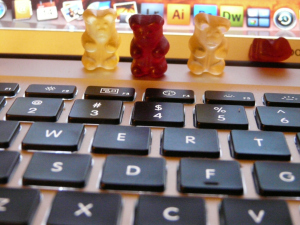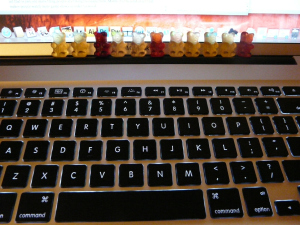September 14, 2009

As young children in rural Tennessee, we had a neighborhood game called German Spotlight: one child was designated the Nazi camp guard, and given a flashlight. The remaining children were declared Jews. Ready, set, go.
My brother brought me back a packet of Gummi Baren from his recent trip to Germany. Tonight, since I am terribly homesick, I was chatting with them as I ate them. They seemed so companionable, I began lining them up along my computer monitor. They have been amazingly enthusiastic about my family brothel anthropology project, which has preoccupied my last several days.
Their years in Germany have perhaps accustomed them to facility with heavy subject matter, and so I am writing to them this evening, all soft and fruity, holding out their arms with absolutely no indication of concern regarding my apparently somewhat grim hide-and-go-seek game of finding and photographing the graves of women whom my great-grandfather may have paid to have sex with, with whom he contracted the sexually transmitted disease that would eventually kill him, and which was probably the reason for my great-grandmother’s psychosis.
As I engage with my unwieldy family brothel anthropology project here at VCCA, I have been thinking about uncomfortable art. Not so much art that is terrifically edgy or transgressive or taboo, just art about things that oftentimes folks really just don’t want to spend a lot of time around.

It’s all well and good for everyone to talk about how political art is important, but when it comes down to the making of political art, you’re bringing into being something that people don’t want to hear a lot of detail about before they go to bed. Or when they’re trying to relax. Maybe it becomes art that is just one more thing from which people are trying to escape.
Maybe it’s the kind of art that makes people watch more game shows in order to avoid.
I vividly remember Piss Christ, and that was intentionally provocative, and people were duly provoked by it. But I’m thinking instead of the artists behind ACT UP (whose work is being featured at Harvard’s Carpenter Center for the Visual Arts this autumn). Folks really absolutely did not want to spend time engaging in any way with work of any kind about a dirty scary sexual disease that involved men’s behinds.
I suspect, however, that the Gummi Baren were quite attentive. They simply sat quietly, arms outstretched, and listened without horror or fear. Tell me more about this AIDS epidemic that has nearly decimated an entire generation of gay men. It’s not a downer at all. In fact, it sounds very important, and I’d like to know what I can do. At the very least, I don’t think we should ignore it. I can’t believe nobody seems to care. It matters a lot because their lives matter a lot.
(That’s more or less the response of my 9th grade class in the assembly hall when we were sat down and told all about it in 1986 by a professor in the Vanderbilt Medical School. We were very calm. Then again, we were mostly Jews. And we were a school of morbidly depressed outcasts and loners. And incidentally, it got many of us extremely interested in the whole “gay” thing, which was the first many of us had heard of such an option. That would be another project: it took a generation of gay people dead in the streets before Southern children could learn that other people had those kinds of feelings about their best friends, too.)
God bless the Gummi Baren.

Imagine German Spotlight, played with Gummi Baren.
A Gummi Baren on either side. Holding the flashlight – a Gummi Baren, fixed, flashlight wedged in the gelatinous paw, arms outstretched: here I am, there you are. let us just regard one another. thank you, that is all.
Then we have the Gummi Baren Jew Team – sitting there, arms outstretched, not hiding, not running, fixed in the light, a certain soft stillness. No movement. Peacefulness. Fruity colored flesh translucent, luminous in the spotlight. A Gummi Baren with tefilin and kippot, perhaps, even better. Unafraid. Completely unafraid, arms outstretched, full of love.
In fact, a game of German Spotlight between two Gummi Baren teams would be an exercise in higher evolution. Nothing hidden, nothing sought. Survival not at stake.
When I began writing the novel Kerosene, I saw the novel as the real story of my women ancestors. Their experiences – which had been so hidden, so secret, so sanitized and unmentionable – would be dignified, redeemed, heard. History has a history of unfriendliness toward the stories of women, be that textbook history, or family history.
In its writing, it mattered to me – and still does – that an avowed friend holds the flashlight, and seeks the shadow-dwellers out at the edges, and welcomes them to a place where they can thrive.
I wanted to be that Gummi Baren holding the flashlight. But I wanted to be both those Gummi Baren: I dearly, desperately, absolutely wanted to be found myself, because perhaps the bulk of my life experience was deemed shadow-worthy, and I was tired of being split in half. Of having to expend so much time hiding so much about my experience.
I dreamed of Alice Walker singlehandedly walking out with the flashlight, and bringing Zora Neale Hurston’s work into the canon, into the present, making vital changes.
My beloved John Berger (check him out) wrote: a story can continue to play an important role wherever the harshness of life is such that people come together to try to change it. Then in the silent spaces of this story both past and future will combine to indict the present.
I keep thinking about how German Spotlight was about hiding and finding and indicting, and the impact of those actions on survival. Darkness can hurt or help. Light can save or damn. Indictment is a powerful weapon. It’s not always as easy to wield as it seems. So much depends on who holds the flashlight, and who is trying to hide.
When the harshness of life is such that people come together to try to change it.
So now. This photography project where I am finding and photographing the houses and graves of the prostitutes my great-grandfather might have known, recording their names and birthdates and addresses and any stories I can find about their lives. I am holding the flashlight on him, on my family. I feel an underlying question is, am I Nazi or gummi baren?
Response to this project has been varied, and mildly disorienting. Why are you doing this, seems to be a common refrain. The novel is about Lafayette’s “legitimate” family, and the photography is about Lafayette’s “secret” family.
The women whom he publicly hurt and humiliated and disempowered were his legal wife, and his legal daughters. Everything legitimate and legal. The word is law. Logic. Language. A novel.
The women whom my great-grandfather privately hurt and humiliated and disempowered were considered criminals, kept so secret they were not allowed to walk on the streets (arrested as street-walkers, while their clients go free). Many times, their houses were accessed by tunnels, so that men could enter a legal business, and go through a tunnel to the brothel. The picture implicates these men. They must stand in the German spotlight. The flashlight in the woods. Photography.

My lifetime – personal, psychological, medical, intellectual, artistic, vocational, avocational – has been an obsession with illuminating what is hidden. But what do you do with it once you have found it? Sure, in and of itself, it’s a very rewarding hide-and-seek game: hunting for the stories of the forgotten and the ignored and the left-behind. But to what end? Justice? I believe in a God, but I don’t know if I believe in justice.
Am I the Nazi with the flashlight? Let’s say I am. Let’s say my years spent working and writing for human rights organizations, a constant shouting about what happens in the shadows of our society, let’s say I have spent my life standing out there in a field with my spotlight, searching. Why?
I find another gummi baren. What do I do?
Today I read a bit of writing by the painter Hyman Bloom (check him out). When asked why he always painted “about” death, he replied that he wanted to make the meaning of death more understandable, even more acceptable, more familiar, more knowable.
That’s why I want to find the homes and graves of the hidden women whom my great-grandfather paid for sex. The women who might have, could have, had children by him. The women we were not to think about, or talk about, or know about, but who lived their lives in plain daylight like the rest of us, just apparently slightly less than truly human.
Not unlike all those men in San Francisco.
Or anyone else who can conveniently vanish from the list of topics when it’s time to have a nice conversation around the dinner table.
When the harshness of life is such that people come together to try and change it.
I am thinking about the difference between what hides itself for self-protection, and what is hidden by others for self-protection. Certainly, the men who profited off the vulnerabilities of 19th century women (all women) were the ones that benefitted by women not being allowed to own property, or walk down a street alone, or receive an education, or vote.
John Berger continued, writing: Art imitates a creation, sometimes to propose an alternative world, sometimes simply to amplify, to confirm, to make social the brief hope offered by nature…the transcendental face of art is always a form of prayer.
For Rosh Hashanah, I declare my atrociously bleak and morbid art project is a prayer. Does that make it more acceptable? It’s a prayer for the gummi baren, on behalf of Hyman Bloom.
Let’s all just start listening and looking at what is hidden and what is revealed without fear, without flinching. Let’s all open our eyes. Let’s get soft and fleshy and luminous, and glow when the light hits us. Let’s open our arms to what is dark and scary and not try to hide from it. let’s make what scares us “more understandable, even more acceptable, more familiar, more knowable.” Because sooner or later, the spotlight is going to come.
Goodnight, Gummi Baren.
gute nacht, quintan!

Hey! I got to leave flowers at the grave of my great grandfather’s mistress in Estonia! It was a very liberating experience. Highly recommended.
…Definitely should be on those lists of things you should do before you die
Admirable, challenging, and inspired.
I definitely do not remember the AIDS discussion. It’s funny the things each person remembers from high school…
We share a respect for John Berger.
how can you not remember that? really? maybe you weren’t at school that day. It was a pivotal moment in my adolescence. Hm. Wonder if Jenny or Matthew remember.
I agree fully. It somehow feels very significant.
You know, this cemetery is full of women and their children who went unclaimed by the fathers…most of the plots are a whole lot of baby graves, and then a large depression where the mother is buried, but she died last and nobody survived her to erect a tombstone. Think of all of us who have ancestral step-siblings we never knew about…from either side of the relationship. The mysteries of errant domesticities…
He has something apt to say about nearly every topic that boggles me. A brilliant fellow.